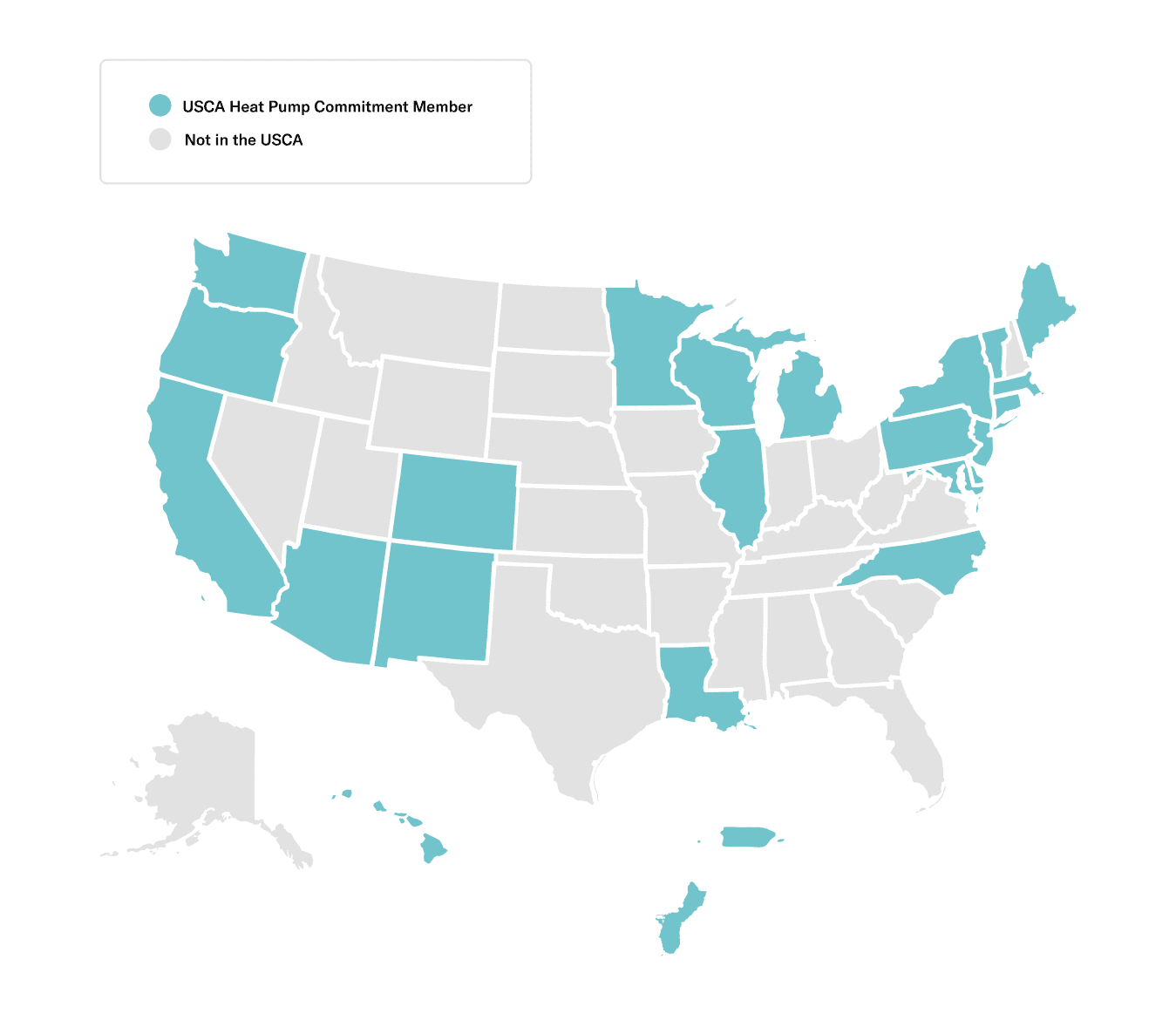Understanding the Pace of Progress and the US Climate Alliance Heat Pump Commitment
Focus points:
Rewiring America’s Pace of Progress tool starts with the assumption that we must meet net-zero emissions targets by 2050. Using current market trajectories for five key electric technologies – heat pumps, heat pump water heaters, induction stoves, solar installations, and electric vehicles – the tool determines how many new installations of these appliances, beyond current trajectories, need to occur to meet our targets by 2050.
The U.S. Climate Alliance’s commitment to install 20 million heat pumps and heat pump water heaters by 2030 is a bold policy initiative that puts its 25 member states and territories roughly 80 percent of the way toward the heat pump installation target for those states and territories outlined in Pace of Progress.
The local Pace of Progress tool estimates the number of new installations needed for each state and county to meet its share of 2050 targets. Local leaders can use this tool to create community level targets that meet the Pace of Progress. USCA governors can use the tool to set goals for other key electric technologies, and state leaders outside the USCA can use it to inform their own electric appliance installation targets.
The background
Rewiring America’s Pace of Progress report examines the market for five key electric technologies — heat pumps, heat pump water heaters, induction stoves, solar installations, and electric vehicles — to determine how many installations need to occur to meet our goal of achieving a net-zero emissions economy by 2050. We found that to meet that target, we must install 24 million new efficient electric machines over current baseline sales nationwide in the next three years. Using this initial analysis, we’ve created the local Pace of Progress tool to establish target projections for each machine type for every state, county, and city across the country so that elected officials and advocates alike can better understand how their community plays a role in electrifying our country and reaching our climate goals.
In September 2023, the US Climate Alliance (USCA) announced a bold new commitment to install 20 million heat pumps and heat pump water heaters in their respective jurisdictions by 2030.
Before diving into how they can work in tandem, it’s important to understand the differences between the USCA heat pump commitment and the Pace of Progress projections.
Analyzing the US Climate Alliance target
The following states and territories collectively committed to installing combined 20 million electric heat pumps and heat pump water heaters by 2030:

This commitment nearly matches the combined heat pump and heat pump water heater deployment targets laid out in the localized Pace of Progress tool within the 23 USCA member states.¹ While there are many pathways to achieve total building decarbonization by 2050, Rewiring America’s analysis estimates that these 23 states will need to install just over 25 million heat pumps and heat pump water heaters by 2030. That means the USCA heat pump commitment of 20 million heat pumps puts these states roughly 80 percent of the way to the total heat pump installation target for 2030 in the Pace of Progress.

In the graph above, the USCA commitment is plotted in blue while Rewiring America’s Pace of Progress target is plotted in yellow. The USCA commitment represents a substantial increase from the current market trajectory of the heat pump and heat pump water heater market, plotted in gray. The USCA and Rewiring America targets are nearly identical for most years of the analysis and only begin to diverge around 2026.
A call to action
The goals set by the governors of the USCA are a model for state leadership on electrification and residential decarbonization and should be replicated by leaders across the country. While the commitment doesn’t put the USCA entirely on track to meet the 2030 Pace of Progress heat pump and heat pump water heater goal, it is a historic step towards electrifying our nation’s housing stock and will catalyze further policy and economic momentum. The local Pace of Progress tool can aid USCA governors in setting targets for other key electric technologies, and provide other state leaders outside the USCA with their own data-informed electric appliance installation targets.
The local Pace of Progress tool also works to address the traditional scarcity of data and necessary resources that local leaders’ face when it comes to making meaningful climate commitments on the community level. By providing community specific appliance targets for cities and counties, local leaders — whether they’re a county supervisor in Los Angeles County or an alderperson in Chicago — can now create local heat pump targets that match or exceed the ambition of the USCA’s state level commitment or Pace of Progress targets for key electric technologies.
Rewiring America’s Pace of Progress analysis estimates that the US needs to deploy 24 million machines — heat pumps, induction stoves, heat pump water heaters, rooftop solar systems, and electric vehicles — above baseline in the next three years. That’s a lot of machines. But those numbers become much more tangible, and therefore achievable, when narrowed to local communities throughout the country. Whether contributing to the laudable goals of the U.S. Climate Alliance or carving a local pathway to electrification, policymakers and organizers can use the local Pace of Progress tool to set the targets that will decarbonize their communities by 2050.
Note: Due to a lack of available data, the Pace of Progress tool is only currently able to model target adoption rates for states, not territories. For the purposes of this analysis, we have excluded Puerto Rico and Guam from our projections.


